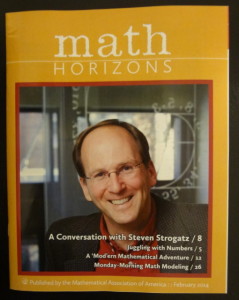 As part of our conversation in the February 2014 issue of Math Horizons, Steven Strogatz shared his thoughts on the current state of math education in the Aftermath section of the magazine.
As part of our conversation in the February 2014 issue of Math Horizons, Steven Strogatz shared his thoughts on the current state of math education in the Aftermath section of the magazine.
Here’s the beginning of his “I have a dream” speech about math teaching.
In my dream world, everyone would have the chance to be a teacher the way Mr. Joffray [Strogatz’s high school calculus teacher and the subject of his book The Calculus of Friendship] was a teacher.
His job was to teach us calculus, but he had his own vision of how to teach it and he followed that vision. He was creative, and he put his personal stamp on the course for us. He trusted his judgment, and the school trusted him. He could teach us the way he wanted to teach us, and he was a great teacher.
Math Horizons makes Aftermath freely available online, so you can read the entire segment here.



